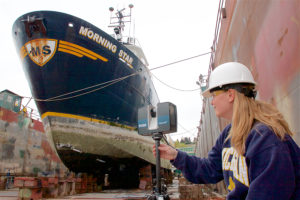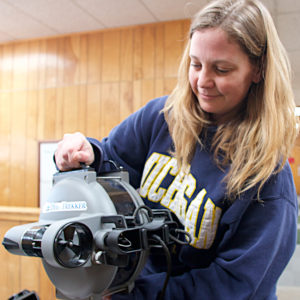Foss is Helping to Lead the Shipyard Industry into the High-Tech World of Marine Robotics

Amanda Dayton prepares to make a laser scan of a fishing vessel in dry dock at Foss Seattle Shipyard.
Naval Architect Amanda Dayton of Foss’ Harbor Marine Group, who is leading a testing program for the high-tech equipment, said she knows of no other shipyard in the region that is exploring the technology as actively as Foss.
The underwater camera, called an ROV or remotely operated vehicle, is controlled through a 75-meter tether and can be used for such things as in-water hull inspections and surveys, internal tank condition assessments, and bid and drydock estimating.
“It produces high-resolution images, so we can tell the condition of the steel underwater and more accurately estimate costs as well as the amount of time that will be needed in drydock,” Dayton said. “We can have a better idea of what’s actually going on.”
The ROV also will be a valuable tool when new Coast Guard regulations go into effect this year requiring frequent surveys of towing vessels.

Dayton displays the submersible camera she uses to take photos of vessel hulls
“The images the scanners make are like pictures, but they are measurable and high precision,” Dayton said. “We can click on different points and get an accurate measurement.
“And these devices are portable,” Dayton said. “I can take them on a ship check and measure pipe that needs to be replaced, and we can prefabricate it before the boat arrives at the yard.
“In the past, we’ve had to wait for a vessel to arrive to measure everything,” she added. “If we can get a leg up on production before the vessel arrives, and then put everything in when it gets here, we can deliver the vessel to the customer more quickly and improve our workflow.”
Dayton got interested in robotics after using a Groupon to purchase an aerial drone, which she also uses to support shipyard projects.
“I wanted to learn more about the technology, and now I’m getting a second masters degree in unmanned systems,” she said. “I don’t think people are aware of all the potential there is in robotics. It’s a really exciting field right now and there’s a lot going on with it.”
Other Foss personnel working on the robotics project include Capt. Lucas Shuler, Harbor Marine Group (HMG) Senior Project Manager Joe Dayton (Amanda’s husband), HMG Naval Architect Janic Trepanier, HMG Project Manager Megan O’Connor, Foss Director of Technical Services Mike Minnig, Shipyard Director Jon Hie and Fleet Engineering Director Tim Stewart. Chief Operating Officer Scott Merritt helped guide the project through the approval and funding process.
Harbor Marine Group is a naval architecture and marine engineering component at Foss that offers its services to external customers.º
